
|
Today's Calendar |
| | Simply Economics |
| | International Perspective |
| | Resource Center |
 |
|
| 1999 Articles |
|
By Evelina M. Tainer Chief Economist, Econoday Employment situation sanguine; NASDAQ soars to new heights
New Dow companies a non-event; NASDAQ's soaring star 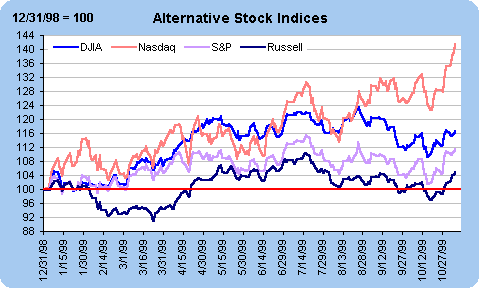 The NASDAQ composite surged to new highs this week. Market players were excited as the NASDAQ approached the 3000 mark earlier this week. Little did they expect the 3100 mark to also be passed this week! The NASDAQ now stands far and above the crowd (of other indexes) and is 41.5 percent higher than the end of 1998. Most analysts are citing the doubling of the index since October 1998, but that incorporates the slide associated with the Russian financial crises and the hedge fund debacle that were rescued by Greenspan and Wall Street banks. But no matter how you slice it, the NASDAQ surge is impressive this year. The S&P 500 performed better than the Dow this past week and managed to generate a 0.5 percent gain from last week. As indicated in the chart above, the S&P is not generally performing very well relative to the Dow. Perhaps the bulk of the index is weighting it down. Indeed, it has been the case for a long time that the price of about 5 to 10 stocks are surging and boosting the index, but the remainder is quite sluggish. Since the S&P is weighted by market capitalization, large growth companies are able to carry more weight. This is misleading for the bulk of the market. The Russell 2000, which measures small capitalization stocks, continues to under-perform. Yet, this past week it jumped 3.1 percent. It has yet to regain this year's highs. It is up from last October only because of the weak yearly comparison. This index never regained the 1998 highs.
Treasury market rallies on employment situation 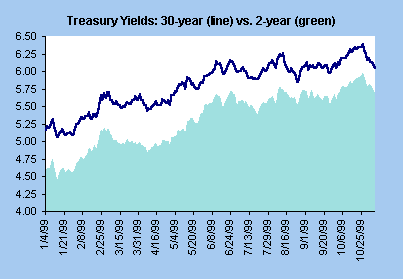
Employment growth healthy; wages stable As usual, service-sector payrolls rebounded after last month's meager gain (probably held back by the impact of Hurricane Floyd). While business and health services contributed to the robust growth, retail trade employment fell for the third straight month. Phil Rones, a senior BLS official, suggested that it could indicate problems with supply (finding workers). On the other hand, he noted that the blip in April and July retail trade employment might indicate a different seasonal pattern for this sector that is not being accurately reflected in the monthly changes. 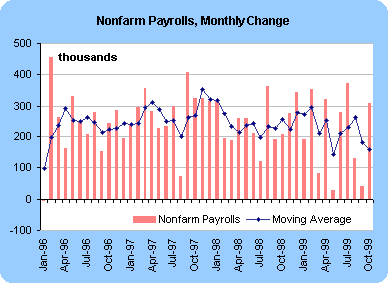 Among the goods producing sector, factory payrolls continued their downward spiral. Given the recovery in factory orders and the NAPM in recent months, this could signal further productivity enhancements. Construction employment rose at the same pace as last month. The monthly gains in this sector are moderating significantly - likely an indication of labor shortages. The moderation in housing, though, may contribute to this softer rate of growth. 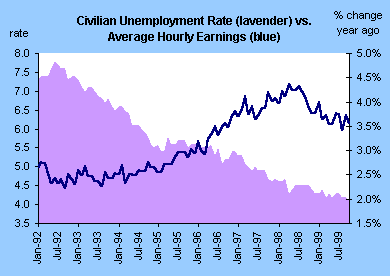 The civilian unemployment rate edged down further to 4.1 percent in October from 4.2 percent in the previous month. The Labor Department does not consider a change of this magnitude statistically significant. Nevertheless, both employment and the labor force posted strong gains for the month indicating a healthy (and tight) labor market. While employment growth surged, average hourly earnings edged up a meager 0.1 percent in October. What a relief for market participants after the 0.5 percent hike last month! Indeed, this sole component of the employment report led to a 8 basis point reduction in the long bond yield (quite a dramatic change!) in the first 20 minutes of trading. At the same time, the initial impact on the stock market was equally robust. The Dow was up 200 points in the first hour of trading. Market players may have overreacted initially; but then again the chart does show that average hourly earnings are holding at the same pace (just over 3 ½ percent) for the past year. The bottom-line on the employment situation? Employment conditions remain favorable, but it does appear that employment growth is moderating from the heady pace of the previous few years. Whether the economy is slowing down because demand is softening, or labor shortages are creating limits, is too hard to tell at this point. Despite the tight labor market, wages remain contained. Average hourly earnings are in a holding pattern. Incidentally, the Fed's Beige Book reported this past week revealed that some Federal Reserve districts have shown sharp wage hikes of 10 - 12 percent. Yet, this was far from the norm. Today's employment report doesn't settle the perennial question: will the FOMC raise the fed funds rate target on November 16. It is a toss up.
Manufacturing sector expanding 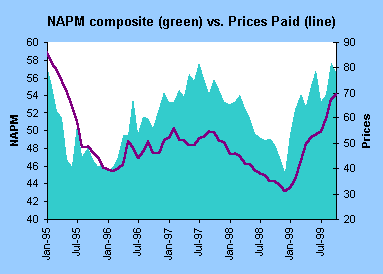 Factory orders declined 0.9 percent in September, not quite offsetting the previous month's gain. The drop was not worrisome after four straight monthly gains. Indeed, on a year-over-year basis, new orders are recovering from the slower pace of late last year. As usual, the growth in information technology equipment seems to outpace the rest of the components. 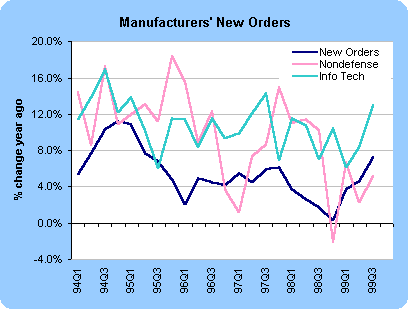 The bottom-line on the manufacturing sector? Manufacturing activity is on an upswing as orders and production stage a comeback after weakness earlier in the year. Productivity gains could be quite robust here considering that factory payrolls are shrinking dramatically. It is likely that export-related industries are likely to improve in coming months given the recoveries in various foreign economies. The October figure marked the ninth straight month in which the new export orders portion of the purchasing managers' report remained above 50 percent.
Personal income revisions show same dismal pattern for savings rate 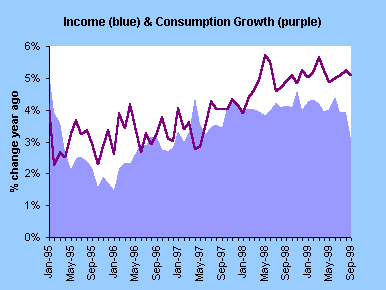 This chart shows year-over-year changes in personal income and personal consumption expenditures. The purple line reflects consumption expenditure growth - which has far exceeded personal income growth for most of this period. No wonder the savings rate is declining at a rapid clip. Since personal income was unchanged in September, disposable income (excluding taxes) actually declined 0.2 percent for the month. As a result, the personal savings rate fell from 2.3 percent in August to 1.6 percent in September. The October employment report suggests a bit of a recovery in income growth, so we could see the savings rate retrace at least part of that loss. The Commerce Department revised personal income and outlays back to 1959 with new data sources and changes in definitions of some of the series. The personal savings rate was redefined and now includes government pension plans. This is not new money, just shifted from another component. Until this revision, the saving rate was in negative territory. Even with this revision, there is no masking the sharp reduction in savings. In 1982, the saving rate was nearly 11 percent. At today's level of 1.6 percent, it can only be described as paltry. It may not be a problem these days with a booming stock market and appreciating home values. But consumers would be in trouble should an exogenous shock lead to a recession. The bottom-line on income and outlays? The September income figures are not true reflections of underlying trends. Nevertheless, consumer spending has outstripped income for several years. Preliminary department store figures suggest that consumer spending may be moderating. Motor vehicle sales fell sharply in October after moderating in September as well. The Fed would love to see a slower consumer sector to avoid inflationary pressures.
THE BOTTOM LINE Federal Reserve officials would surely like to see some moderation in consumer spending. Since consumer expenditures account for two-thirds of GDP, a slowdown in this sector would go a long way in curtailing economic activity and labor demand. A Fed rate hike remains a toss up. Yet, many analysts do believe that whether the Fed raises rates or not, doesn't matter for the financial markets. At this time, many think that this would be the last hike for quite a while. So a rally may ensue if rates increase or not.
Looking Ahead: Week of November 8 to 12
Wednesday Market participants are expecting new jobless claims to increase 2,000 in the week ended November 6 from last week's 288,000. Claims remain range-bound.
Thursday
Friday Nonfarm productivity is expected to grow at a 3.0 percent rate in the third quarter after a meager 0.6 percent gain in the April to June period. At the same time, unit labor costs should rise at a 1.5 percent rate, significantly less than half the 4.5 percent pace recorded in the previous quarter. |
|||||||||||||||||||||||||||||||||||||||||||||||||||||||||||||||||||||||||||||||||||||||||||